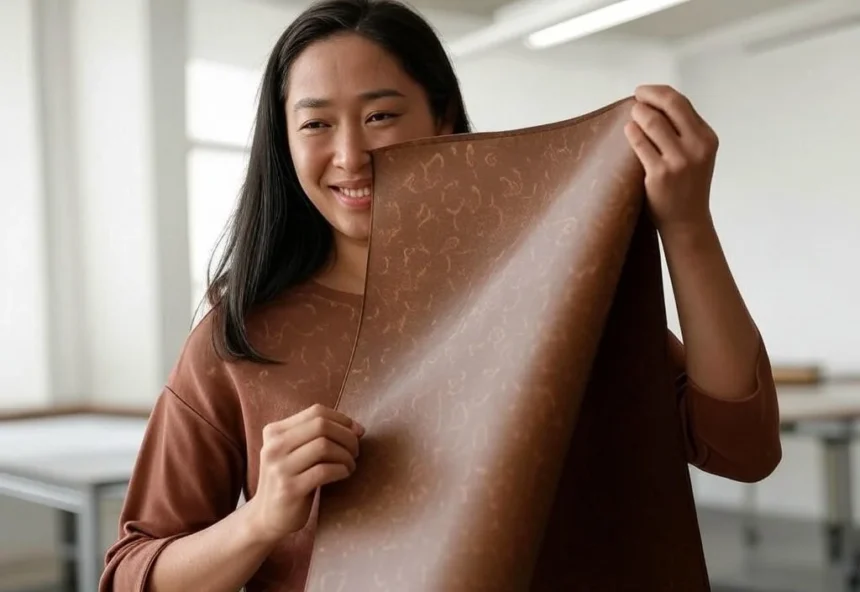Introduction
As concerns about climate change, environmental degradation, and animal rights continue to rise, many industries have shifted towards more sustainable practices. One of the sectors undergoing significant transformation is the fashion and materials industry, particularly regarding leather goods. Traditional leather, while popular for its durability and luxurious feel, is also associated with a range of ethical and environmental challenges, including animal cruelty and the pollution created during the tanning process. Enter Leatheling – a groundbreaking material that is making waves in the world of sustainable leather alternatives. Designed to mimic the look, feel, and performance of traditional leather without the environmental and ethical concerns, Leatheling has emerged as a viable, eco-friendly substitute that meets the needs of modern consumers. This article explores Leatheling in depth, including its production process, benefits, applications, and care instructions.
By the end, you’ll have a comprehensive understanding of why Leatheling is becoming a go-to choice for manufacturers and consumers who want to embrace sustainability without sacrificing quality or style.
What is Leatheling?
It is an innovative material that replicates the characteristics of traditional leather but with far fewer environmental impacts. Unlike genuine leather, which is made from animal hides, Leatheling is typically composed of recycled fibers, plant-based substances, or synthetic polymers that emulate the texture, flexibility, and appearance of leather. Its development is part of a larger trend toward finding sustainable alternatives to everyday materials that can be harmful to the environment.
It often combines multiple materials, such as:
- Recycled Leather Fibers: These are collected from waste products from the leather industry, such as leftover scraps or factory trimmings. These fibers are processed, bonded, and treated to create a material that has the aesthetic properties of leather but without the associated animal-based processes.
- Plant-Based Materials: Some Leatheling products incorporate natural ingredients like cork, pineapple leaves, or even mushrooms. These materials offer a sustainable way to produce a leather-like material that is biodegradable and non-toxic.
- Polyurethane (PU): In some instances, Leatheling is produced by combining natural fibers with a synthetic resin like PU. This hybrid material is flexible, durable, and suitable for various applications, from fashion to furniture.
Key Characteristics of Leatheling
Durability and Longevity
One of the primary reasons consumers opt for Leatheling is its exceptional durability. Despite being a synthetic alternative, Leatheling possesses strength comparable to genuine leather. This makes it an ideal material for items that need to withstand daily wear and tear, such as wallets, handbags, belts, and even shoes.
Moreover, Leatheling is often designed to become more pliable over time, much like traditional leather. As it ages, it can develop a distinctive patina that adds character and uniqueness to each item, further blurring the line between synthetic and genuine leather.
Eco-Friendly Production
Traditional leather production has long been criticized for its negative environmental impact. The tanning process, which uses harmful chemicals like chromium and formaldehyde, can contaminate water sources and harm local ecosystems. Additionally, raising animals for leather production contributes to deforestation, water depletion, and greenhouse gas emissions.
Leatheling, however, is a more sustainable option. The production of Leatheling generally involves fewer harmful chemicals and much less water than the tanning of animal hides. By using recycled materials and plant-based components, Leatheling drastically reduces the environmental footprint of leather goods. Some manufacturers even use a zero-waste approach in their production processes, ensuring that minimal waste is generated.
Softness and Flexibility
Leatheling isn’t just durable – it’s also comfortable to use. Thanks to its innovative production methods, Leatheling can be soft, flexible, and pleasant to touch, offering the same luxurious feel that genuine leather is known for. Whether you’re wearing a Leatheling jacket or sitting on a Leatheling-upholstered sofa, the material provides the perfect balance of comfort and structure.
Additionally, Leatheling is less prone to cracking and fading over time, a common issue with synthetic leathers. This makes it a versatile option for a variety of products that require both aesthetics and functionality.
Versatility in Design
Leatheling’s ability to be produced in various finishes, colors, and textures gives designers more freedom to experiment with unique designs. It can be embossed, textured, dyed, and shaped to suit a variety of needs, from fashion items like bags and shoes to car interiors and furniture upholstery.
The flexibility of Leatheling makes it a favorite choice for designers looking for a cruelty-free, eco-conscious material that can still meet the demands of the fashion industry.
Benefits of Choosing Leatheling
Ethical Considerations
One of the most compelling reasons to opt for Leatheling over traditional leather is its ethical appeal. Traditional leather production requires the slaughter of animals, raising concerns among animal rights advocates. For consumers who want to avoid contributing to animal cruelty, Leatheling offers a sustainable and cruelty-free alternative without compromising on quality or style.
By choosing Leatheling, consumers can support industries that prioritize animal welfare and ethical sourcing.
Cost-Effectiveness
In addition to being environmentally friendly and ethically sound, Leatheling is often more affordable than traditional leather. The cost of producing Leatheling is lower because it doesn’t rely on animal farming, which can be expensive due to the costs of raising livestock and processing animal hides.
This makes Leatheling a more accessible option for consumers who want the luxury of leather but at a lower price point. Whether you’re buying a stylish handbag, a sofa, or a car seat, Leatheling provides high-quality alternatives at a more budget-friendly price.
Low Maintenance
Traditional leather requires significant care to maintain its appearance. It needs to be conditioned regularly, protected from moisture, and cleaned with specific products to avoid damage. Leatheling, on the other hand, is much easier to maintain. It is resistant to moisture and stains, making it ideal for everyday use.
With Leatheling, consumers can enjoy leather-like products without worrying about regular upkeep. This makes it a practical choice for people who want low-maintenance items without compromising on luxury.
Applications of Leatheling
1. Fashion Industry
Leatheling has quickly become a sought-after material in the fashion industry, where it is used to create a wide range of accessories and apparel. Designers are using Leatheling to make handbags, shoes, jackets, belts, and wallets that not only look and feel like traditional leather but also align with modern consumers’ growing environmental concerns.
Leatheling is especially popular among consumers who prefer cruelty-free products but don’t want to sacrifice style. It allows them to make a fashionable, ethical choice without contributing to animal exploitation or environmental harm.
2. Automotive Sector
In the automotive industry, Leatheling is being utilized for car interiors, offering a luxurious and eco-friendly alternative to genuine leather. Car manufacturers are adopting Leatheling for seats, upholstery, steering wheel covers, and other interior elements, meeting the demands of consumers who want to drive a vehicle with less environmental impact.
Not only is Leatheling more sustainable, but it is also highly durable, making it an ideal material for use in vehicles that need to endure daily wear and tear while maintaining their aesthetic appeal.
3. Furniture and Upholstery
Leatheling is gaining popularity in the furniture industry, especially in the production of sofas, chairs, and other upholstered items. Its flexibility, durability, and luxurious appearance make it a strong contender for use in high-end furniture. Leatheling is available in a range of colors and textures, making it an attractive choice for both contemporary and classic designs.
Moreover, Leatheling furniture is often easier to maintain than traditional leather furniture, which requires more attention to prevent drying, cracking, or fading.
Caring for Leatheling Products
While Leatheling is low-maintenance compared to traditional leather, it still requires some care to ensure its longevity. Here are a few tips for keeping your Leatheling products in top condition:
Cleaning
Leatheling can be easily cleaned by wiping it down with a damp cloth to remove surface dirt and grime. For deeper cleaning, use a mild soap solution or a specialized cleaner designed for synthetic or eco-friendly materials. Avoid using harsh chemicals, as they can degrade the material over time.
Storage
Store Leatheling products in a cool, dry place to avoid exposure to direct sunlight, which could cause the material to fade or warp. It’s also important to avoid storing Leatheling items in damp areas, as excess moisture could weaken the material.
Moisture Protection
Leatheling is more resistant to moisture than traditional leather, but it’s still best to keep it dry. If you spill something on your Leatheling item, blot the spill with a clean, dry cloth immediately to prevent staining. Leatheling items that get wet should be allowed to air dry naturally, away from direct heat sources.
Leatheling vs. Traditional Leather: A Detailed Comparison
| Aspect | Leatheling | Traditional Leather |
| Source | Made from recycled fibers, synthetic materials, or plant-based substances. | Made from animal hides, primarily cows, goats, and pigs. |
| Environmental Impact | Low due to sustainable production methods and use of recycled materials. | High due to intensive farming, deforestation, and chemical tanning processes. |
| Ethical Considerations | Cruelty-free, as it doesn’t involve animal products. | Involves animal farming, raising concerns among animal rights activists. |
| Cost | More affordable due to lower production costs. | Typically more expensive due to animal farming and leather processing. |
| Maintenance | Low maintenance; resistant to stains and moisture. | Requires regular conditioning and special care to avoid drying or cracking. |
| Durability | Comparable to traditional leather; resistant to wear and tear. | Highly durable but prone to wear and tear over time. |
Conclusion
Leatheling is at the forefront of the movement towards more sustainable, ethical alternatives to traditional leather. Its eco-friendly production methods, durability, and versatility make it an excellent choice for consumers and industries looking for high-quality materials that minimize environmental impact.
Whether you are in the fashion, automotive, or furniture industry, or simply someone who values sustainability in their personal products, Leatheling offers a viable and responsible alternative to conventional leather. As more industries adopt this material, it is likely that Leatheling will become even more prevalent, contributing to a greener, more ethical world.
By embracing Leatheling, we can enjoy the luxurious feel and timeless appeal of leather while helping protect our planet and its inhabitants.
FAQs About Leatheling
What is Leatheling made of?
Leatheling is made from a mix of recycled leather fibers, plant-based materials, or synthetic compounds. These components are bonded together to mimic the look and feel of traditional leather without harming animals or the environment.
Is Leatheling eco-friendly?
Yes, Leatheling is considered eco-friendly. Its production uses fewer chemicals, less water, and often recycles waste materials. This reduces pollution and helps lower the overall environmental impact compared to traditional leather.
How durable is Leatheling compared to real leather?
Leatheling is designed to be strong and long-lasting, just like genuine leather. It can handle daily use without cracking or fading and is often resistant to moisture and stains, making it very durable.
Can Leatheling be used in fashion products?
Absolutely. Leatheling is widely used in the fashion industry to make shoes, bags, belts, and jackets. It offers the same stylish appearance as leather but is more ethical and sustainable.
How do you clean Leatheling items?
Cleaning Leatheling is easy. Use a soft cloth with mild soap and water to wipe the surface. Avoid strong chemicals and let it air dry away from direct heat or sunlight.
Is Leatheling more affordable than traditional leather?
Yes, Leatheling is usually more budget-friendly. Because it doesn’t involve animal farming or expensive tanning processes, it costs less to produce, which often leads to lower prices for consumers.






